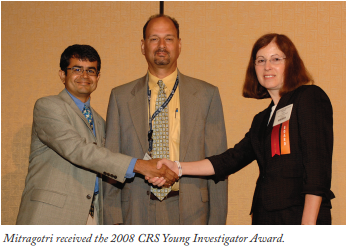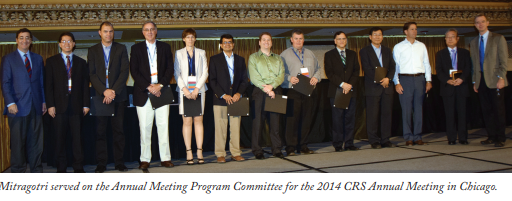Interview: Biomaterial and Drug Delivery Focused Research with Samir Mitragotri at University of California, Santa Barbara
 Samir Mitragotri is a prominent leader in the field of drug delivery and biomaterials. His contribution in the field of transdermal drug delivery was noticed by the community when his group successfully published the delivery of vaccines (proteins), insulin (peptides), and siRNA via skin into the blood stream using painless needlefree methods like sonophoresis (low frequency ultrasound) and liquid jet injector, which could have a potential impact in the field of HIV, hepatitis C, and hepatitis B. Another research area, which led to multiple insightful publications, is the development of mathematical models to describe and predict transport across the skin and mucosal barriers. Dr. Mitragotri has made significant contributions in the development of novel mucoadhesive polymer devices, biomaterials with carefully designed morphologies for targeted drug delivery, and cell-based nanoparticle delivery methods. His group is also active in creating biodegradable and biocompatible particles with the size, shape, and flexibility of red blood cells and synthetic platelets with applicability in the field of pathology and drug delivery.
Samir Mitragotri is a prominent leader in the field of drug delivery and biomaterials. His contribution in the field of transdermal drug delivery was noticed by the community when his group successfully published the delivery of vaccines (proteins), insulin (peptides), and siRNA via skin into the blood stream using painless needlefree methods like sonophoresis (low frequency ultrasound) and liquid jet injector, which could have a potential impact in the field of HIV, hepatitis C, and hepatitis B. Another research area, which led to multiple insightful publications, is the development of mathematical models to describe and predict transport across the skin and mucosal barriers. Dr. Mitragotri has made significant contributions in the development of novel mucoadhesive polymer devices, biomaterials with carefully designed morphologies for targeted drug delivery, and cell-based nanoparticle delivery methods. His group is also active in creating biodegradable and biocompatible particles with the size, shape, and flexibility of red blood cells and synthetic platelets with applicability in the field of pathology and drug delivery.
His current research focuses on understanding fundamental processes in biological systems and development of new biomaterials and technologies for diagnosis and treatment of various pathological conditions including diabetes, cardiovascular disease, and infectious disease. With the intent of bringing the academic research to commercial application, Dr. Mitragotri has cofounded seven companies: Sontra, fqubed, Stratagent, Seventh Sense, Dx, Entegra, and Convoy.
Dr. Mitragotri obtained his bachelor’s degree in chemical engineering from the Institute of Chemical Technology (ICT) in Mumbai, India, in 1992 and his Ph.D. from Massachusetts Institute of Technology (MIT) in Cambridge, MA, U.S.A., in 1996. He has since been a faculty member in the Department of Chemical Engineering at the University of California, Santa Barbara (UCSB). He also served as the founding director of UCSB’s Center for Bioengineering and director of translational medical research laboratories. He has published over 175 publications, given over 250 invited lectures, and is an inventor on 90 pending or issued patents. His work has been cited over 14,000 times and has been highlighted by various popular news media, including the New York Times, USA Today, and Discover Magazine. He has mentored over 50 graduate students and postdocs and over 100 undergraduate students.
He has been awarded multiple national and international recognitions, including the CRS Young Scientist Award, American Institute of Chemical Engineers Allan P. Colburn Award for his outstanding publication record, and world’s top young innovators award (TR35) by MIT’s Technology Review magazine in 1999. He is an elected fellow of the National Academy of Inventors, American Association for the Advancement of Science, and American Institute for Medical and Biological Engineering. He currently serves as an associate editor of the Journal of Controlled Release.
Q: What makes the red blood cells and blood platelets being developed in your laboratory potentially superior over other biomaterials being used for the same purpose? Have you already performed animal studies on these particles, and what are the results?
A: The unique feature is that the materials developed in our laboratory provide morphological mimicry of natural red blood cells and platelets. Many synthetic materials that are designed for intravascular drug delivery suffer from limited vascular circulation, low targeting, and the inability to negotiate biological barriers. To further complicate the matter, these requirements must be met simultaneously while also limiting toxic effects on the patient. Mother Nature has already provided us with many examples where these tasks are successfully performed. These examples include red blood cells and platelets. We have developed synthetic particles that provide morphological mimicry of these natural cells. Our research has shown that such morphological mimicry plays an important role in their biological function. This observation fits into the bigger question that we pose in our lab, that is, while it is known that specific interactions mediated by ligand-receptor association are ubiquitous in biology, does the physical form of ligand presentation defined by the size, shape, deformability, and so on impact the biological outcome? Our research indeed demonstrated that physical parameters underlying ligand presentation do matter. Specifically, synthetic particles that mimic the shape and flexibility of natural platelets exhibit better binding to vascular injuries compared with their spherical and rigid counterparts. This finding forms the basis of our platelet-like nanoparticles. We have performed in vivo studies with our platelet-like nanoparticles, which showed excellent wound targeting and hemostasis. These studies have been recently published in ACS Nano.
Q: Please tell us about some of the exciting research projects being investigated in your lab.
A: Several exciting research projects are ongoing in our lab; I will mention two in the interest of space.
The first project deals with the treatment of bacterial biofilms that build up in tissues, especially skin. Biofilm-protected microbial infections in skin are a serious health risk that remains to be adequately addressed. The lack of progress in developing effective treatment strategies is largely due to the transport barriers posed by the stratum corneum of the skin and the biofilm itself. We have developed ionic liquids for simultaneous biofilm disruption and enhanced antibiotic delivery across the skin layers. This work establishes the use of ionic liquids for topical drug delivery and as a new arsenal of materials against antibiotic-resistant bacterial infections in skin.
The second project deals with targeted delivery of drugs and imaging agents to inflamed tissues, which are often found in cases of cancer, Alzheimer’s disease, and arthritis. We use monocytes for this purpose, as they possess a unique ability to target and penetrate into sites of inflammation. We take advantage of the natural ability of monocytes to target inflammation and deliver flat polymeric particles (“cellular backpacks”) that attach strongly to the surface of monocytes but do not undergo phagocytosis because of the cellular backpack’s disk-like shape and flexibility. In two separate in vivo inflammation models, backpack-laden monocytes exhibited increased accumulation in inflamed tissues. Cellular backpacks, and their abilities to attach to monocytes without impairing monocyte functions and to “hitchhike” to a variety of inflamed tissues, offer a new platform for both cell-mediated therapies and targeting inflamed tissues.

Q: What are the top five research articles from your laboratory that have made the most impact?
A: It is a challenge to select a handful of papers because the impact can be measured in so many different ways. Some articles have made a deep impact on fundamental understanding, whereas others have led to a new technology. Nevertheless, here is a list of five representative papers:
Hsu, T, Mitragotri, S. Delivery of siRNA and other macromolecules into skin and cells using a peptide enhancer, Proc. Natl. Acad. Sci. U.S.A. 108: 15816-15821 (2011). This article reports a peptide identified by phage display named skin penetrating and cell entering (SPACE) peptide for transdermal delivery of siRNA and other macromolecules. siRNAs are potential therapeutics for various dermatological diseases including psoriasis, atopic dermatitis, and cancer. Their utility is, however, limited by their low absorption across the stratum corneum and into viable cells of skin. SPACE peptide offers a potential solution to this problem.
Doshi, N, Zahr, A, Bhaskar, S, Lahann, J, Mitragotri, S. Red blood cell-mimicking synthetic biomaterial particles, Proc. Natl. Acad. Sci. U.S.A. 106: 21495-21499 (2009). Inspired by the superior design properties of red blood cells, we synthesized particles that mimic the key structural and functional features of red blood cells. Similar to their natural counterparts, red blood cell–mimicking particles reported in this article possess the ability to carry oxygen and flow through capillaries smaller than their own diameter. Further, they can also encapsulate drugs and imaging agents. These particles provide a paradigm for the design of drug delivery and imaging carriers because they combine the functionality of natural red blood cells with the broad applicability and versatility of synthetic drug delivery particles.
Champion, JA, Mitragotri, S. Role of target geometry in phagocytosis, Proc. Natl. Acad. Sci. U.S.A. 103: 4930-4934 (2006). This manuscript reports a surprising finding that particle shape plays a dominant role in phagocytosis by macrophages. Specifically, the local shape determines the complexity of the actin structure that must be created to initiate phagocytosis and allow the membrane to move over the particle. Failure to create the required actin structure results in simple spreading and not internalization.
Arora, A, Hakim, I, Baxter, J, Rathnasingham, R, Srinivasan, R, Fletcher, DA, Mitragotri, S. Needle-free delivery of macromolecules across the skin by nanolitervolume pulsed microjets, Proc. Natl. Acad. Sci. U.S.A. 104: 4255-4260 (2007). Despite their long history, needle-free liquid jet injectors are not commonly used as a result of frequent pain and bruising. We hypothesized that pain and bruising originate from the deep penetration of the jets and can potentially be addressed by minimizing the penetration depth of jets into the skin. Using a new strategy of jet injection, pulsed microjets, we reported on the delivery of protein drugs into the skin without deep penetration. The high velocity (v > 100 m/s) of microjets allows their entry into the skin, whereas the small jet diameters (50–100 µm) and extremely small volumes (2–15 nanoliters) limit the penetration depth (approximately 200 µm).
Karande, P, Jain, A, Mitragotri, S. Discovery of transdermal penetration enhancers by high-throughput screening, Nat. Biotechnol. 22: 192-197 (2004). In this paper, we reported particular mixtures of penetration enhancers that increase skin permeability to macromolecules (approximately 1–10 kDa) by up to approximately 100-fold without inducing skin irritation. The discovery of these mixtures was enabled by an experimental tool, in vitro skin impedance guided highthroughput (INSIGHT) screening, which is >100-fold more efficient than current tools.
Q: You have been involved in commercial translation of several of your technologies. What are some of the major challenges faced during translation of research ideas into commercial products, and what did you learn in the process?
A: The journey of a technology from ideation to a commercially successful drug delivery system is long and difficult, as evidenced by a small number of FDA-approved products that utilize advanced drug delivery systems in spite of a strong early research pipeline. At each step of translation, there exist roadblocks that can slow down progress. In our efforts to translate our ideas into products, we have encountered our fair share of challenges and have learned several lessons.
The first lesson is to put the idea to a rigorous test in its early stages. Ideas that form the foundation of potential products need to be tested and verified as soon as possible. Proof of concept in vivo studies are essential in confirming that the concept is viable and can provide therapeutic benefits. Given the high rate of fallout during in vitro to in vivo translation, it is critical that the idea be put to the in vivo test as soon as possible.
Following up with strong publications and patents is also key. Strong publications provide validation of significant scientific breakthroughs through peer review. Patents, obviously, are an essential component of commercial development as well. Another lesson we learned from these experiences is to value simplicity. All things being equal, a simple solution is a winning solution. Simplicity is not often considered a key principle in academic research; hence, a critical evaluation of the technology from the perspective of simplicity must take place. Having the right group of individuals and collaborators around the technology is also the key. Converting academic technology into a product requires a team with diverse expertise working with the right mindset.
Q: What are future topics of interest in your laboratory research?
A We are working on several new areas within drug delivery. One topic of particular interest is hybrid synthetic-biological methods for targeted drug delivery. Synthetic carriers provide several advantages including drug encapsulation and precise engineering, whereas biological systems, in particular circulatory cells such as red blood cells and monocytes, provide unique advantages including long circulation and deep tissue penetration. Hybrid systems that combine synthetic and biological systems offer advantages of both systems while avoiding their limitations. Another area of interest is ratiometric drug delivery systems. Combinations of drugs are more effective compared with single drugs for many diseases, especially cancer. However, delivery of drug combinations in controlled proportions is a significant challenge and requires systems that are able to independently incorporate and release multiple drugs.
Q: After finishing graduate school, what made you choose an academic career? How did your background from MIT and ICT affect that decision-making process? Which individuals have had an impact on you?
A: Ever since I can remember, I have found an academic career very appealing. I was fortunate to have phenomenal mentors throughout my education, especially at MIT and ICT. I idolized them and wanted to become like them. That’s the primary reason for me choosing an academic career. I have been deeply influenced by my mentor Bob Langer. His approach to research, his way of thinking about problems, and his pursuit of solutions have been a source of inspiration. I have also been impacted by my students. They have brought their own views and approaches to our research group and have thus enriched my life. I am extremely proud of their accomplishments and success.
Q: Please share your hobbies and interests with the readers.
A: I enjoy traveling, especially to places of historical significance. They showcase the creativity and ingenuity of individuals of earlier eras, and I find that inspiring. I enjoy running and biking in the foothills and on the shores of Santa Barbara. They have inspired me to run more often and eventually led me to complete several half-marathons and a full marathon in southern California over the last couple of years.
Q: What career advice would you give to younger professionals starting in grad schools, industry, and academia?
A: My advice to young professionals is to nurture the spirit of creativity and innovation. The field is in constant need of creative, out-of-the-box ideas that can have a transformative impact. I think that the young professionals entering the field are in the best position to come up with such paradigmshifting ideas; however, it takes a special effort to nurture the creative spirit, and the young professional should make that effort.

